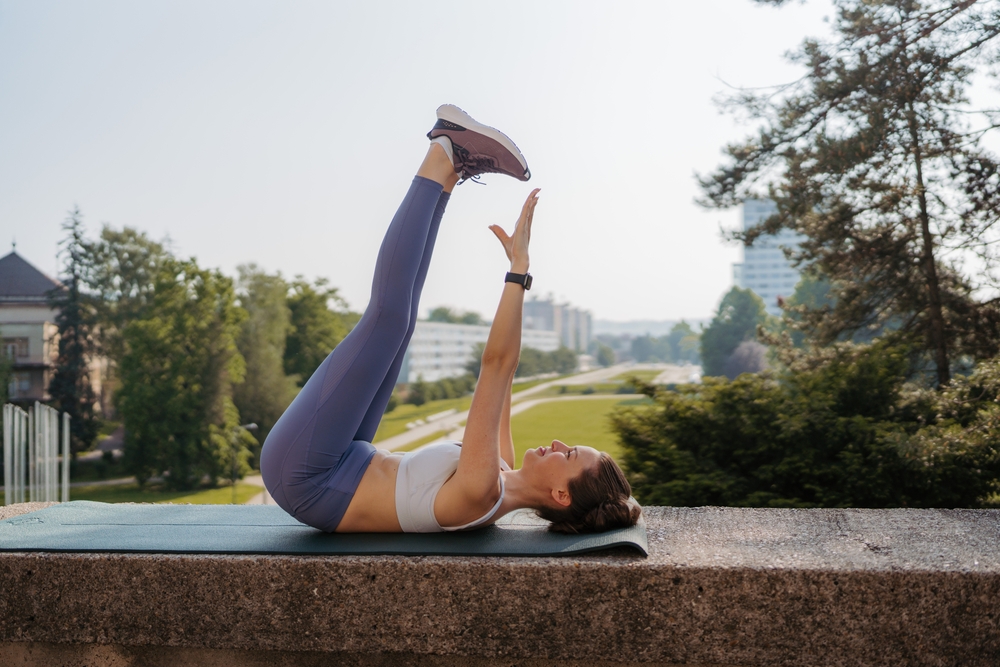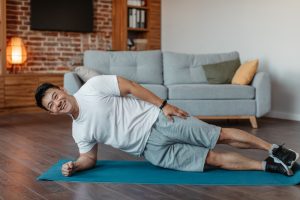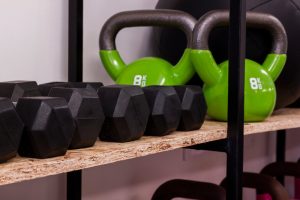Vertical leg crunches are a core exercise where you lie on your back with legs straight up and lift your upper back off the floor using your abs—not your neck or momentum.
To get the most out of them, you need controlled movement, steady breathing, and proper form throughout.
Keep reading for a detailed step-by-step guide, mistakes to avoid, and tips to modify or level up the exercise.
What Are Vertical Leg Crunches—and Why Should You Care?
If you’re looking for an effective, no-equipment way to build core strength, vertical leg crunches offer a simple yet powerful option.
They’re a variation of the standard crunch, but with one important twist—your legs are held straight up, which changes the demands on your core and challenges your stability in a different way.
Unlike regular crunches, where your feet stay on the floor, vertical leg crunches involve lifting your legs so they’re pointing straight up toward the ceiling.
This adjustment isn’t just for looks—it shifts more of the work to your abdominal muscles, particularly the rectus abdominis, while forcing you to engage your stabilizers to maintain proper form.
Your hip flexors, transverse abdominis, and even your obliques and lower back also join in to support the movement.
Keeping your legs vertical during the crunch makes it harder for your body to cheat.
You can’t rely on momentum as easily, and your core has to stay active the entire time to prevent your lower back from lifting off the floor.
This encourages better spinal alignment and deeper core activation, making each rep more effective.
Another reason vertical leg crunches stand out is their versatility.
You don’t need any gear, which makes them ideal for travel or at-home workouts.
You can use them as a standalone core move, mix them into a superset, or plug them into a warm-up or finisher depending on your training goals.
They’re especially useful when:
- You want a more intense alternative to standard crunches without adding weights
- You’re designing a workout routine that doesn’t rely on machines or equipment
- You’re working on improving core control, posture, or spinal support
Whether you’re an athlete training for performance, someone building functional strength, or just looking to stay consistent while traveling, this variation delivers a lot of return for a small investment of space and effort.
Step-by-Step: How to Do Vertical Leg Crunches With Proper Form
To get the full benefit of vertical leg crunches, precision matters more than speed or rep count.
Every part of the movement—from how you set up to how you breathe—affects how well your core muscles activate.
Here’s how to perform them with proper form, so each rep actually works for you, not against you.
Start by lying flat on your back, preferably on a mat or soft surface.
Extend your legs straight up so they’re perpendicular to the floor, keeping them as close together as possible.
A slight bend at the knees is okay—it can even help with stability—but don’t let your legs drift forward or sway outward.
If you feel wobble or strain, try crossing one ankle over the other to lock in the position.
Next, choose your arm placement.
You can either reach your hands straight up toward your toes or gently rest them behind your head.
If you go with the second option, don’t pull on your neck—your hands are there only for light support.
Pulling can lead to unnecessary strain and takes the effort away from your abs, which defeats the purpose of the exercise.
Before you move, lock in your core.
Draw your belly button inward as if trying to pull it toward the floor.
This activates your deep abdominal muscles and helps flatten your lower back firmly against the ground.
Your lower back should stay pressed down the entire time—if it lifts, your core has disengaged and you need to reset.
Now, begin the crunch.
Lift your shoulder blades and upper back off the ground using your abs.
Instead of curling your head or yanking your neck forward, imagine lifting your chest straight up toward the ceiling.
It’s more of a vertical lift than a forward one.
That change in direction is what targets the core more directly and limits compensation from other muscles.
At the top of the movement, hold for one full second.
Don’t rush through it—this pause increases the time your abs stay under tension and improves overall control. From there, slowly lower back down.
Resist the temptation to drop quickly.
A slow descent not only prevents momentum from taking over but also challenges your muscles during the return phase of the rep.
Make sure your breathing supports your movement.
Exhale as you crunch up—this naturally tightens the abs—and inhale deeply as you lower back down.
Matching your breath to your motion helps keep your form clean and your focus sharp.
Done correctly, a set of vertical leg crunches can deliver more impact in fewer reps than traditional crunches.
Focus on quality, not speed, and aim for control in every phase of the motion.
Avoid These Common Mistakes That Ruin Your Crunches
Even with a seemingly simple move like the vertical leg crunch, it’s surprisingly easy to slip into poor habits that limit results or invite injury.
These aren’t just technical nitpicks—they’re issues that can significantly reduce core engagement and shift the work to the wrong muscles.
Being aware of what to avoid is just as important as knowing how to do the exercise right.
One of the most common mistakes is pulling on your neck with your hands.
You might notice this if your neck feels sore after crunches or if you find yourself leading the movement with your head instead of your chest.
When you do this, your neck takes on stress it’s not meant to handle, and your abs take a back seat.
If your hands are behind your head, they should only act as a gentle cradle. You’re not pulling—just supporting.
If you struggle with this, try switching to the arms-reaching-to-toes variation, which keeps your hands completely away from your head.
Another issue is using momentum to power through reps.
It can be tempting to swing your arms or let your legs move around as you crunch, especially when fatigue sets in.
But when your body starts to rely on momentum, your muscles disengage, and the exercise becomes much less effective. The key here is to slow down.
Move deliberately, and treat each rep as its own controlled effort.
If your arms or legs start flying around, that’s a sign you’re rushing and need to tighten up your form.
Losing control of your leg position is another subtle but telling sign your core isn’t fully engaged.
Legs that drift forward or sway side to side usually indicate that your deep stabilizing muscles aren’t doing their job.
If you catch this happening, reset by pressing your lower back into the floor and actively squeezing your thighs together.
Some people find it helpful to cross one ankle over the other to create more stability and reduce movement.
It’s also critical to keep your lower back in firm contact with the floor throughout the exercise.
Letting it arch is a major red flag—it reduces core tension and increases the risk of strain in your lumbar spine.
If you find your lower back lifting, pull your belly button inward and reduce the range of motion slightly until you can maintain contact.
Without this connection, the entire movement loses its core focus.
Poor technique not only makes the exercise less productive—it can also lead to unnecessary discomfort or even injury.
Doing fewer reps with excellent form will always beat doing more reps with sloppy execution.
When you take shortcuts, your abs don’t get the stimulus they need, and other muscles step in to compensate.
That can create imbalances, limit progress, and, in some cases, cause pain.
Paying attention to these red flags and correcting them in real time helps you get more out of every rep.
It keeps the exercise safe, efficient, and aligned with its purpose—targeting your core in a controlled, meaningful way.
Progressions That Push Your Core to the Next Level

Once you’ve mastered the basic vertical leg crunch with clean, controlled form, the next step is increasing the challenge.
Rather than simply adding more reps, you can progress the movement in smart ways that build deeper strength, improve endurance, and keep your workouts from going stale.
A simple adjustment is switching to the toe reach variation. Instead of placing your hands behind your head, extend your arms straight up and actively reach toward your toes as you crunch.
This change shifts more of the effort to your upper abs and forces better coordination through your trunk.
It also discourages neck strain, since there's no hand contact with your head at all.
Another great progression is incorporating pulse reps at the top of the crunch.
Once you've lifted your upper back off the floor, instead of lowering right away, hold the top position and perform several short, controlled pulses—about 5 to 10.
These tiny movements keep your muscles under constant tension and burn out the core faster than full-range reps alone.
If you're looking to make the exercise more intense without adding reps, try lowering your legs from vertical to a 45-degree angle.
This increases the demand on your core stabilizers, especially the lower part of your rectus abdominis and your transverse abdominis.
The challenge here isn’t just lifting—it's maintaining that leg position while still keeping your back pressed to the floor.
If your lower back starts to arch, ease off and work back up gradually.
To increase resistance, you can add a small weight, such as a dumbbell or plate.
Hold it on your chest or, for a harder option, just behind your head—but only if you can maintain strict form.
Adding load should never come at the expense of control or spinal contact.
If you're straining or speeding through reps, drop the weight and refocus on quality.
Vertical leg crunches can also be integrated into larger core routines to train your trunk from multiple angles.
Pair them with movements like hanging leg raises for lower abs, Russian twists or wood chops for rotational strength, or planks for overall stability.
This kind of variety not only builds a well-rounded core but also helps prevent plateaus.
Each of these progressions adds a different layer of difficulty. The key is not to rush—make sure your form is locked in at each stage before advancing.
With consistency and smart tweaks, you’ll continue making gains without ever needing to overhaul your routine.
Safe Regressions If You’re Just Getting Started
If vertical leg crunches feel too demanding at first, that’s completely normal.
They require core strength, coordination, and flexibility—all of which take time to develop.
The good news is, there are several ways to scale the movement so you can still build a solid foundation without compromising your form or comfort.
One of the easiest adjustments is to bend your knees rather than keeping your legs straight up.
This reduces the tension on your hamstrings and takes some stress off the lower back, making it easier to maintain proper positioning.
You’ll still work your abs, but without fighting for stability in your legs.
It’s a great in-between step that builds control before progressing to the full vertical version.
If even that feels like too much, consider bringing your feet down entirely and placing them flat on the floor, hip-width apart.
This turns the move into a traditional crunch, which is more forgiving and ideal for reinforcing core engagement and breathing technique.
Focus on lifting your shoulder blades with precision and keeping your lower back pressed into the ground from start to finish.
Another option is to limit your range of motion. Instead of lifting as high as possible, aim for a smaller crunch—just enough to raise your shoulder blades slightly off the floor.
A controlled mini-rep with good form is far more effective than a big, loose one.
Over time, you’ll gain the strength and control to extend the movement without strain.
No matter which regression you choose, what matters most early on is quality.
That means maintaining consistent breathing (exhaling on the way up, inhaling on the way down), keeping your core engaged, and moving with control.
Don’t worry about reps or sets at first—focus on clean execution.
As your core gets stronger, you can gradually build toward the vertical leg version.
Start by raising your legs to tabletop position (knees bent at 90 degrees), then straighten them over time as stability improves.
This step-by-step path makes progress feel manageable and keeps you injury-free along the way.
By starting with these regressions, you set yourself up for success.
You’re not just going through the motions—you’re building proper habits that will support stronger, more effective core training down the line.
How to Fit Vertical Leg Crunches Into Your Routine
Knowing how to perform vertical leg crunches is only part of the equation—knowing where they fit into your broader training plan is just as important.
Whether you're working out at home, at the gym, or on the road, this movement can slot in easily to enhance your core training without taking much time or space.
For most people, doing 2 to 4 sets of 10 to 20 reps is a solid starting point.
Beginners may want to stick closer to the lower end of that range, while those with more experience and control can push toward the higher rep counts.
Quality matters more than quantity, so if form breaks down, cap the set and rest.
The tempo also makes a big difference in how effective the exercise is.
Each rep should include a one-second pause at the top—right when your shoulder blades are off the floor—followed by a slow, controlled descent.
Rushing through reps often leads to momentum taking over, which reduces the load on your core and weakens the training effect.
In terms of frequency, two to three times a week works well for most routines.
That’s enough to stimulate muscle growth and improve core endurance without risking burnout.
However, because vertical leg crunches are low-impact and don’t require equipment, you can do them more often—as long as you’re not experiencing fatigue or lower back discomfort.
On days when you do them back-to-back, reduce volume slightly or vary intensity using regressions.
These crunches are flexible enough to be used in different parts of a workout.
You can plug them into a core circuit, pair them in supersets with moves like planks or bird-dogs, or use them as a focused finisher after your main lifts.
They also work well as a travel-friendly solution when you're away from the gym and short on equipment.
If you’re building a more complete ab routine, try pairing vertical leg crunches with exercises that target other core functions.
For example, you could combine them with hanging leg raises to hit the lower abs or add planks or side planks for stability.
This kind of complementary training creates a well-rounded core, improving not just how your abs look, but how they function under load or in athletic movement.
Ultimately, vertical leg crunches are easy to integrate, don’t require a lot of setup, and scale well with your fitness level.
Add them to your weekly plan with intention, focus on form and control, and you’ll see steady gains without needing to overcomplicate your routine.
Conclusion
Vertical leg crunches offer a simple, equipment-free way to strengthen your core—when done with proper form.
Focus on control, steady breathing, and thoughtful progressions or regressions based on your level.
Add them into your routine consistently, and they’ll deliver solid returns without the need for complex setups.







